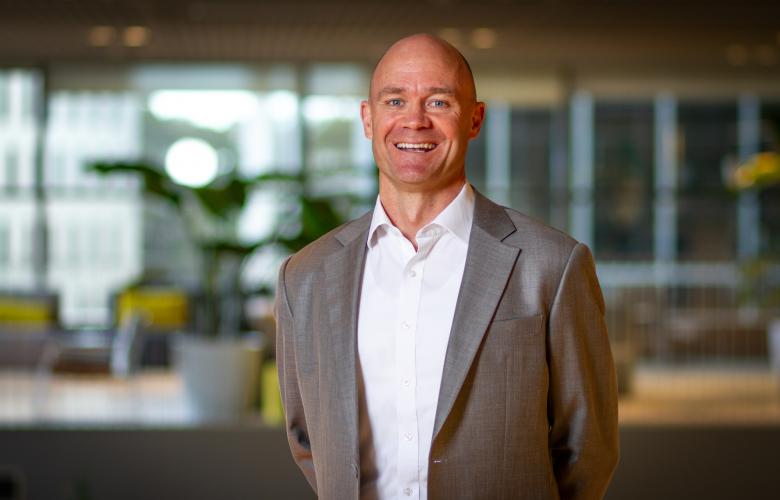New Frasers Property Australia CEO Anthony Boyd outlines strategy
Contact
New Frasers Property Australia CEO Anthony Boyd outlines strategy
Anthony Boyd takes over as Frasers Property Australia CEO today as outgoing-CEO Rod Fehring commences an Executive Chairman role at Frasers Property Australia.
Today marks a changing of the guard at Frasers Property Australia. New CEO Anthony Boyd officially takes over as Rod Fehring, after five years in the CEO role, now begins a new chapter as Executive Chairman of Frasers Property Australia while continuing as chair of Frasers Property Industrial and Frasers Property UK.
The change also heralds a new structure; one which recognises and builds on the strength of Frasers Property’s residential, commercial, retail and community development expertise, yet which creates an environment of greater cohesion on the development front to deliver more valuable assets to the investment management side of the business.
At a glance:
- Anthony Boyd takes over as Frasers Property Australia CEO today
- Outgoing-CEO Rod Fehring now Executive Chairman, Frasers Property Australia
- New organisational structure to take the business forward
- Leveraging expertise across asset classes and property uses will be critical for future project
The Frasers Property business will look quite different to the one Mr Fehring took control of in 2015. Perhaps the most obvious change was the 2019 separation of Frasers Property Industrial as a stand-alone international business under the leadership of Australian-based CEO Reini Otter.
“The change in leadership is part of our planned succession and given the broader global context, not just for property but for business and society generally, this is the appropriate time for Frasers Property Australia to look to the future,” Mr Fehring says.
“It has been an honour and privilege to serve as CEO, I’m immensely proud of the team, and I know Anthony will prove more than capable of solidifying a strong, resilient and profitable business going forward.”
Mr Fehring’s new role leverages his international credentials, having been instrumental in the formation of Frasers Property Limited’s integrated industrial and logistics platform, and helping to establish the Group’s UK platform in close partnership with the UK leadership team.
A new CEO
Anthony Boyd comes from a finance background and has broad experience across the Frasers Property Australia business.
With over 25 years’ experience in the property and finance industries, he joined the Frasers Property team in 2005 as Group Financial Controller before taking on the roles of General Manager Finance and General Manager Operations in the Residential Division.
Following a move to Melbourne in 2014 to run Frasers Property’s Victorian Residential business, he advanced to the role of Executive General Manager Residential in 2015 and most recently held the position of Chief Financial Officer.
Mr Boyd paid homage to his predecessor.
“Our business is in the strong, resilient place it is today because of Rod’s leadership. Our core competencies are well-defined, our financial platform is robust, our team is diverse, our culture is inclusive, our green credentials are market-leading and a licence to innovate is instilled throughout all levels of our company,” Mr Boyd says.
A new philosophy, a new structure
During his tenure as CFO, Mr Boyd had the opportunity to clarify his own thinking on a new philosophical approach to development more appropriately suited to 2020 and beyond.
It led to the establishment of a new organisational and financial framework that will underpin Frasers Property’s strategy in the years ahead. This framework is based on capabilities rather than sectors, with development and investment management at its core. The development business is now run nationally by Cameron Leggatt, while investment management is run by Mark Gleeson.

Image: Frasers Property Australia and Dexus unveil $2.5 billion Sydney Tech Central towers
According to Mr Boyd, the new structure “better reflects our core functions and ensures a better outcome for our customers, whether they be residents of our communities or people who work, shop and socialise in the places we create.”
And in the future, these customers will not simply belong to one part of the business. Developments requiring a range of product types, multiple uses and degrees of flexibility will be a key focus for the company as the property industry innovates to meet the new needs of people, communities, businesses and Governments.
“We believe this structure delivers benefits in synergy and cohesion between our core sector competencies as the goal in each case is shared. Instead of our residential, commercial and retail teams working as independent units, they are instead an integrated development team working as one to deliver the best possible outcomes for our customers,” Mr Boyd says.
“This structure will serve us increasingly well, including on complex projects, where we seek to leverage our cross-sector capabilities to meet demands for a cohesive, whole-of-precinct outcome. This aspiration drives all of our projects, including new mixed-use and town centre-style projects, and especially those in which we partner with Government.
“As customer preferences continue to evolve across markets, we will also draw on our strong hospitality capability as we develop aligned products and services such as build-to-rent.”
In terms of the evolution of strategy, in addition to its core residential developments, Mr Boyd says Frasers Property will target complex and challenging projects where innovation and long term thinking allows the business to create stronger, smarter and happier neighbourhoods that promise greater futures.

Image: Frasers Property Australia and Dexus unveil $2.5 billion Sydney Tech Central towers
“This is equally important for retail and commercial office developments. Having a strong focus on fostering communities in a residential context provides insights and capabilities that help us facilitate authentic connections between commercial tenants, employees, retailers and their customers.
“In a time where disconnection and fear have impacted countries around the world, people have naturally reverted to thinking more locally. We understand that ‘belonging’ is fundamental to individual and collective success. We will continue to undertake projects such as Central Park, Ed.Square, Brookhaven, Central Place Sydney and Burwood Brickworks that enable us to create that belonging,” he says.
The company’s strategic ambition also focuses on growth.
“We want to leverage our platform through capital partnerships to better utilise our capabilities in our key markets and increase assets under management. We have a number of aligned, long term partners and we will look to leverage these and new relationships to grow the business through both development and investment management opportunities,” Mr Boyd says.
A market forever changed
As companies grapple with what a post-COVID-19 – or at least a ‘pandemic-prepared’ – world looks like, Mr Boyd identifies numerous reasons for confidence in the resilience of Australian housing.
“Speculative housing supply is not a characteristic of Australian housing markets as it is for many global markets. It means, when demand for new housing reduces, the supply response is very quick. Projects don’t commence if they are not supported by pre-sale commitments. This ensures that demand and supply in Australia remains broadly in balance, which underpins values to a degree,” he explains.
“What supports housing in the longer term is population and employment growth. But even where those macro demand drivers appear subdued in the short term, a reduction in the number of new dwellings being completed will ensure that markets do not move into a position of material oversupply.
“As with previous market downturns, reduced dwelling commencements and completions will have a bigger impact on jobs than on house prices. While new housing supply will reduce and the volumes of dwelling sales will reduce, we expect that the broad supply/demand balance, together with low interest rates, will provide a degree of stability for house prices generally. This will be reliant on Government support, as is currently being provided in the short to medium term.
“There are also longer term, big picture questions the industry must address as we plan for the future,” Mr Boyd says.

Image: Frasers Property Australia and Dexus unveil $2.5 billion Sydney Tech Central towers
The intrinsic value younger people place on home ownership, for one. And how affordability and proximity to other amenity are driving changes in household formations, for another.
“We must consider that younger generations might apply a different value weighting to home ownership against other ways to spend their money, such as travel, lifestyle and other experiences. Family preferences are also changing in terms of aging in place, extended family living arrangements and working from home more often, among other shifts,” Mr Boyd says.
“Build-to-rent may be one product development response among a broader suite of solutions, together with innovative ownership models and mortgage solutions. Evolution in this realm could take many different forms.
“We’re focused on the concept of building communities based on a deeper understanding of our customers. It necessitates an elevated emphasis on masterplanning and design. More than bricks and mortar, successful neighbourhoods respond to how people use places and connect with others in their community.
“Convenience of local retail amenity, ease of access to schools and workplaces, and transport connections drive additional value for customers.
“There are opportunities to enhance peoples’ experience of a place where they work, live, socialise or, as is increasingly likely, do a collection of these things. This requires long term thinking about how different elements can be activated and how space inside and outside of buildings can be flexible.
“Perhaps all homes of the future will encompass a more suitable, practical study or office space. Or perhaps communities will incorporate shared spaces and activated hubs in separate areas for their tenants and residents, both indoors and outdoors, which could accommodate work and facilitate connection.
“WiFi precincts and amenity in community central parks. Shared office resources in community buildings and retail centres. The role of neighbourhoods as more than places to live is shifting,” Mr Boyd says.
On housing stimulus measures
Mr Boyd acknowledges the efficiency with which Governments have implemented stimulus measures to underpin business and consumer confidence. This has ensured household income has been supported and people have been incentivised to purchase homes that are newly built or under construction.
This has helped to support a lot of construction jobs where the normal demand from immigration and overseas students has fallen away. Mortgage holidays from banks have also helped mortgagees who may otherwise have had difficulty meeting repayments on time.
But there have been some misses, Mr Boyd argues, especially in terms of the HomeBuilder scheme and its ability to stimulate only a narrow segment of the market.
“The Australian housing market is diverse and requires a broad range of dwelling types and sizes to cater for different customers. HomeBuilder does not cater to the breadth of housing choices needed for all Australians,” Mr Boyd says.
“For instance, due to the scheme’s timing triggers, the apartment market and medium density segment is largely missed.
“It is incumbent on creators of homes to provide choice for people with different needs and budgets, and at different stages of their lives. It is important therefore that Government broadens its incentives to stimulate these different sectors of the market so that housing can contribute to the economic recovery to its full potential,” he says.
Similar to this:
Dexus and Frasers unveil $2.5 billion Sydney Tech Central towers
Proposed $2.5 billion Sydney tech precinct moves closer to approval
Tim Gurner announces $150 million strategic acquisitions partnership with Qualitas for new sites










